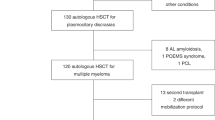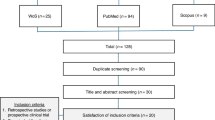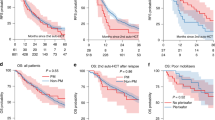Abstract
Autologous stem cell transplantation (auto-HSCT) is an effective treatment strategy for hematological malignancies. The standard mode of handling hematopoietic progenitors for the autologous procedure (CRYO) consists on its collection and freezing with dimethyl sulfoxide (DMSO) and its subsequent thawing and re-infusion. This process is toxic and expensive. Non-cryopreserved (non-CRYO) is a less expensive mode of auto-HSCT. We designed a comparative study between both strategies performed in two different centers to analyze the short-term complications. In total 111 auto-HSCT were performed from January/2015 to October/2016 (42 non-CRYO and 74 CRYO). There were 74 males and 69 (62%) patients had the underlying diagnosis of multiple myeloma. No differences were seen on the characteristics of the apheresis products and their viability. Engraftment was significantly faster in the non-CRYO group (p = 0.001). Febrile neutropenia and severe mucositis were lower in the non-CRYO group (40% vs 92% p = 0.0001 and 11% vs 64%, p = 0.001, respectively). In addition, length of hospitalization was 5 days shorter in the non-CRYO group (p = 0.0001). Overall responses and transplantation outcomes were similar. Our data demonstrate a clear advantage of the non-CRYO over CRYO auto-HSCT with faster engraftment, lower incidence of febrile neutropenia and shorter hospital stay after the transplantation procedure. These data are especially relevant for centers with high transplant activity or with limited resources.
This is a preview of subscription content, access via your institution
Access options
Subscribe to this journal
Receive 12 print issues and online access
$259.00 per year
only $21.58 per issue
Buy this article
- Purchase on SpringerLink
- Instant access to full article PDF
Prices may be subject to local taxes which are calculated during checkout

Similar content being viewed by others
References
Naumann-Winter F, Greb A, Borchmann P, Bohlius J, Engert A, Schnell R. First-line tandem high-dose chemotherapy and autologous stem cell transplantation versus single high-dose chemotherapy and autologous stem cell transplantation in multiple myeloma, a systematic review of controlled studies. Cochrane Database Syst Rev. 2012;10:CD004626.
Sibon D, Morschhauser F, Resche-Rigon M, Ghez D, Dupuis J, Marçais A, et al. Single or tandem autologous stem-cell transplantation for first-relapsed or refractory Hodgkin lymphoma: 10-year follow-up of the prospective H96 trial by the LYSA/SFGM-TC study group. Haematologica. 2016;101:474–81.
Bakken AM. Cryopreserving human peripheral blood progenitor cells. Curr Stem Cell Res Ther. 2006;1:47–54.
Kessinger A, Armitage JO, Landmark JD, Smith DM, Weisenburger DD. Autologous peripheral hematopoietic stem cell transplantation restores hemopoietic function following marrow ablative therapy. Blood. 1988;71:723–7.
Zenhäusern R, Tobler A, Leoncini L, Hess OM, Ferrari P. Fatal cardiac arrhythmia after infusion of dimethyl sulfoxide-cryopreserved hematopoietic stem cells in a patient with severe primary cardiac amyloidosis and end-stage renal failure. Ann Hematol. 2000;79:523–6.
Benekli M, Anderson B, Wentling D, Bernstein S, Czuczman M, McCarthy P. Severe respiratory depression after dimethylsulphoxide-containing autologous stem cell infusion in a patient with AL amyloidosis. Bone Marrow Transplant. 2000;25:1299–301.
Hoyt R, Szer J, Grigg A. Neurological events associated with the infusion of cryopreserved bone marrow and/or peripheral blood progenitor cells. Bone Marrow Transplant. 2000;25:1285–7.
Morris C, de Wreede L, Scholten M, Brand R, van Biezen A, Sureda A, et al. Should the standard dimethyl sulfoxide concentration be reduced? Results of a European Group for Blood and Marrow Transplantation prospective noninterventional study on usage and side effects of dimethyl sulfoxide. Transfusion. 2014;54:2514–22.
Syme R, Bewick M, Stewart D, Porter K, Chadderton T, Glück S. The role of depletion of dimethyl sulfoxide before autografting: on hematologic recovery, side effects, and toxicity. Biol Blood Marrow Transplant. 2004;10:135–41.
Stiff PJ, Dahlberg S, Forman SJ, McCall AR, Horning SJ, Nademanee AP, et al. Autologous bone marrow transplantation for patients with relapsed or refractory diffuse aggressive non-Hodgkin’s lymphoma: value of augmented preparative regimens–a Southwest Oncology Group trial. J Clin Oncol. 1998;16:48–55.
Li J, Hamilton E, Vaughn L, Graiser M, Renfroe H, Lechowicz MJ, et al. Effectiveness and cost analysis of “just-in-time” salvage plerixafor administration in autologous transplant patients with poor stem cell mobilization kinetics. Transfusion. 2011;51:2175–82.
Attarian H, Feng Z, Buckner CD, MacLeod B, Rowley SD. Long-term cryopreservation of bone marrow for autologous transplantation. Bone Marrow Transpl. 1996;17:425–30.
Cox MA, Kastrup J, Hrubisko M. Historical perspectives and the future of adverse reactions associeated with haematopoietic stem cells cryopreserved with dimtethyl sulfoxide. Cell Tissue Bank. 2012;13:203–15.
Ager S, Scott MA, Mahendra P, Richards EM, Jestice HK, Boraks P, et al. Peripheral blood stem cell transplantation after high-dose therapy in patients with malignant lymphoma: a retrospective comparison with autologous bone marrow transplantation. Bone Marrow Transplant. 1995;16:79–83.
Naithani R, Rai R. Non-cryopreserved storage is feasible for autologous stem cell transplantation in multiple myeloma previously treated with melphalan. Clin Transplant. 2012;26:E449.
Ahmed T, Wuest D, Ciavarella D, Ayello J, Feldman EJ, Biguzzi S,D, et al. Marrow storage techniques: a clinical comparison of refrigeration versus cryopreservation. Acta Haematol. 1991;85:173–8.
Durie BG, Harousseau JL, Miguel JS, Bladé J, Barlogie B, Anderson K, et al. International Myeloma Working Group. International uniform response criteria for multiple myeloma. Leukemia. 2006;20:1467–73.
Cheeson BD, Fisher RI, Barrington SF, Cavalli F, Schwartz LH, Zucca E. Recommendations for initial evaluation, staging, and response assessment of Hodgkin and non-Hodgkin lymphoma: the Lugano classification. J Clin Oncol. 2014;32:3059–68.
Ruiz-Argüelles G, Gomez-Rangela D, Ruiz-Delgado G, Ruiz-Argüelles A, Pérez-Romano B, Rivadeneyra L. Results of an autologous noncryopreserved, unmanipulated peripheral blood hematopoietic stem cell transplant program: a single-institution, 10-year experience. Acta Haematol. 2003;110:179–83.
Mabed M, Shamaa S. High-dose chemotherapy plus non-cryopreserved autologous peripheral blood stem cell transplantation rescue for patients with refractory or relapsed hodgkin disease. Biol Blood Marrow Transpl. 2006;12:942–8.
Papadimitriou CA, Dimopoulos MA, Kouvelis V, Kostis E, Kapsimali V, Contoyannis D, et al. Non-cryopreserved peripheral blood progenitor cells collected by a single very large-volume leukapheresis: a simplified and effective procedure for support of high-dose chemotherapy. J Clin Apher. 2000;15:236–41.
Cuellar-Ambrosi F, Karduss UA, Gomez WR, Mondragon MC, Velasquez-Lopera M, Calles S, et al. Hematologic reconstitution following high-dose and supralethal chemoradiotherapy using stored, noncryopreserved autologous hematopoietic stem cells. Transplant Proc. 2004;36:1704–5.
Holowiecki J, Giebel S, Wojnar J, Krawczyk-Kulis M, Stella-Holowiecka B, Kachel L, et al. Autologous hematopoietic stem cell transplantation for high-risk Hodgkin’s disease: a single-center experience with the first 100 patients. Transplant Proc. 2002;34:3378–83.
Sierra J, Conde E, Iriondo A, Brunet S, Marin J, Pérez de Oteiza J, et al. Frozen vs. nonfrozen bone marrow for autologous transplantation in lymphomas: a report from the Spanish GEL/TAMO Cooperative Group. Ann Hematol. 1993;67:111–4.
Kayal S, Sharma A, Iqbal S, Tejomurtula T, Cyriac S, Raina V. High-dose chemotherapy and autologous stem cell transplantation in multiple myeloma: a single institution experience at All India Institute of Medical Sciences, New Delhi, using non-cryopreserved peripheral blood stem cells. Lymphoma Myeloma Leuk. 2014;14:140–7.
Wannesson L, Panzarella T, Mikhael J, Keating A. Feasibility and safety of autotransplants with noncryopreserved marrow or peripheral blood stem cells: a systematic review. Ann Oncol. 2007;18:623–32.
Wang EH, Chen YA, Corringham S, Bashey A, Holman P, Ball ED, Carrier E. High-dose CEB vs BEAM with autologous stem cell transplant in lymphoma. Bone Marrow Transplant. 2004;34:581–7.
Köpler H, Pfluger KH, Havemann K. Hematopoietic reconstitution after high-dose chemotherapy and autologous nonfrozen bone marrow rescue. Ann Hematol. 1991;63:253–8.
Carella AM, Santini G, Giordano D, Frassoni F, Nati S, Congiu A, et al. High-dose chemotherapy and non-frozen autologous bone marrow transplantation in relapsed advanced lymphomas or those resistant to conventional chemotherapy. Cancer. 1984;54:2836–9.
Lisenko K, Pavel P, Kriegsmann M, Bruckner T, Hillengass J, Goldschmidt H, et al. Storage duration of autologous stem cell preparations has no impact on hematopoietic recovery after transplantation. Biol Blood Marrow Transplant. 2016;23:684–90.
Parody R, Caballero D, Márquez-Malaver FJ, Vázquez L, Saldaña R, Madrigal MD, et al. To freeze or not to freeze peripheral blood stem cells prior to allogeneic transplantation from matched related donors. Eur J Haematol. 2013;91:448–55.
Author information
Authors and Affiliations
Corresponding author
Ethics declarations
Conflict of interest
The authors declare that they have no conflict of interest.
Rights and permissions
About this article
Cite this article
Sarmiento, M., Ramírez, P., Parody, R. et al. Advantages of non-cryopreserved autologous hematopoietic stem cell transplantation against a cryopreserved strategy. Bone Marrow Transplant 53, 960–966 (2018). https://doi.org/10.1038/s41409-018-0117-5
Received:
Revised:
Accepted:
Published:
Issue date:
DOI: https://doi.org/10.1038/s41409-018-0117-5
This article is cited by
-
Non-cryopreserved autologous peripheral blood stem cell transplantation for multiple myeloma and lymphoma in countries with limited resources: practice considerations from the Worldwide Network for Blood and Marrow Transplantation
Bone Marrow Transplantation (2025)
-
Cryopreserved versus non-cryopreserved stem cell autografts in multiple myeloma a restrospective cohort study
Bone Marrow Transplantation (2022)
-
Winter is coming: the future of cryopreservation
BMC Biology (2021)
-
Cryopreserved versus non-cryopreserved peripheral blood stem cells for autologous transplantation after high-dose Melphalan in multiple myeloma: comparative analysis
Bone Marrow Transplantation (2019)
-
Hematopoietic stem cell transplantation using non-cryopreserved peripheral blood stem cells graft is effective in multiple myeloma and lymphoma
Bone Marrow Transplantation (2018)



